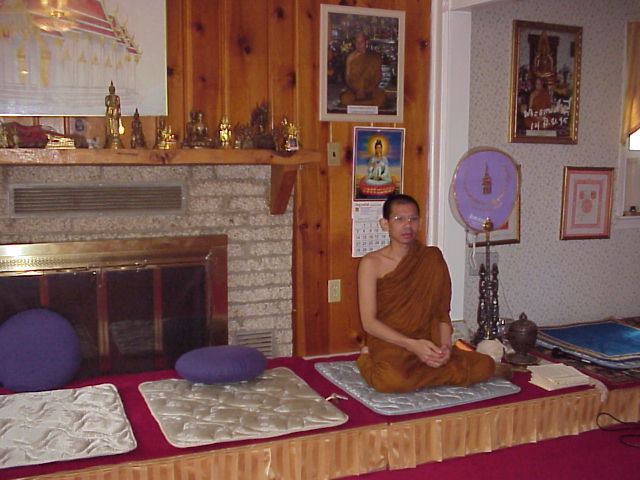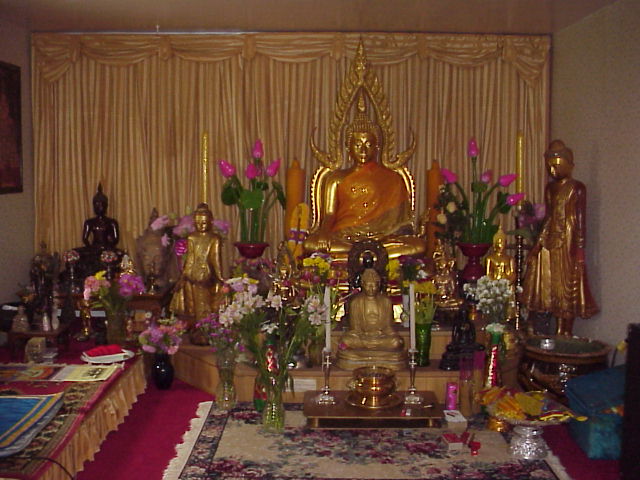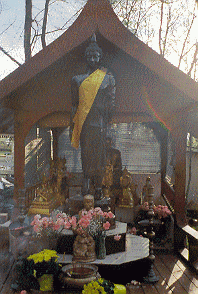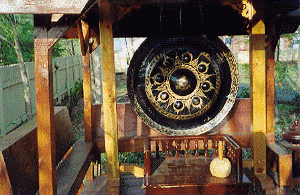|
It was bright and sunny when I finally reached the monastery after some difficulty and stopping to ask directions. I was expecting a secluded place, set off in the woods away from any main roads, with trees screening it away from the nearest neighbors but that is not quite what I got. The temple did have a certain peacefulness to it, a warm breeze ruffled the leaves and the small houses had a rustic eastern serenity to them that I found appealing. I could hear the traffic from Rt. 28 and the knowledge that a strip mall with a seedy movie rental place and the Buffalo Wing Factory were right around the corner seemed to take away from it. The lay out of the compound itself was aesthetically pleasing, trees lined the narrow driveway that wound around the flora. The two main buildings were small and well kept. From the parking lot, in the shade of trees green with new growth we made our way to what I presumed to be the main building. Before we reached the front door a short, balding Asian man wearing a loose orange robe greeted us. He had a thick accent and I think he was a little nervous at first, but he invited us into the monastery after I told him I was taking a class on eastern religions at NOVA. Inside the monastery to the right of the doorway a small group of young men in orange robes who I presumed to be some kind of students were writing in the Thai language on a big piece of poster board.
Right as the ceremony ended the monk got a phone call. He answered with a simple hello before talking in Thai for a few minuets. The phone call was kind of strange; it had been easy to forget that we were in northern Virginia and then here is this very American, modern convenience in the monastery. As the monk talked on the phone I looked around for any other conveniences, toaster ovens, cell phones but all I saw was a rather nice looking computer in a small office on the north side of the building. After the ceremony the ten-pound bag of rice was dragged away. The monk tried to decipher our names from the guest book, he got reasonably close, and he asked if we wanted to meditate or just have a look around the compound. I told him I just wanted to look around, he seemed a little disappointed that we didn’t want to meditate but he proved to be quite an interesting tour guide.
On the other side of the small pond was a second gazebo with a huge gong, roughly four feet across with a large bulge in the center and multiple smaller bulges out towards the edge. The monk took up a large padded mallet and hit the gong twice, making a pair of sweet peals. He told us to do it and my friend and I both took a swing at the gong smiling like fools.
He stopped and stepped back smiling, I’m sure, at our shocked faces. My friend stepped up to the gong and began rubbing it with a vengeance, his hand squeaking he was rubbing so hard. All he managed to get out of the gong was a slight buzz right as he stopped. I tried next, rubbing hard too but I got better results. I quickly found out you get the best effect with a light touch and at the end I had it going as loud as the monk had with just a feather touch of my fingers. The monk led us away from the gong, back in front of the main building towards the back of the compound where hundreds of tables and chairs were leaning against a shed. The monk told us it was Thai New Years coming up and that we should come back, there would be lots of food, some free, some not and that it would be quite a party. Next to the shed was an old truck, tires gone, up on cider blocks looking like it would never run again. In the south west corner of the compound four small buildings not more than ten feet on a side were where the monks lived in the summer, so they could meditate without any distractions. They had a kind of swing set up, to meditate, it looked quite interesting, though somewhat difficult to get on and off of. Separating the four small buildings and the swing was a partially finished wall where the monk said they put the ashes of their dead. The last building was a kind of school where meditation was taught in both English and Thai and you could come learn Thai every week for free. He seemed quite inviting that we should come learn, that it was free, and that we should come learn. He gave quite an in depth tour of the house, going so far as to show us the bathrooms and laundry room. He showed us shelves full of books and pushed several on us, and inviting us to take as many as we wanted. After the tour he sat us down on the floor and began talking about Buddhist philosophy. He told us that life is suffering and about four mountains that do a lot of crushing and how a table really isn’t a table how its just a bunch of separate parts that make up other things. All I could think of was that if the wood and nails and color (paint) wasn’t a table than it should be a chair. He was very interesting and had a lot to say but his English or maybe my Thai just couldn’t cover it all. After he had finished his philosophical lesson he asked us about what we were studying and where we had lived and told us he had been born in a southern province in Thailand. We small talked for a while. He wanted to know about Boston since I had lived there. He told us we should visit Thailand, it was a very nice place, and we would have a good time. When we finally got out of there, and it took some trying, my back was killing me from sitting on the floor for so long. It was still warm and breezy outside, we made our goodbyes to the monk, knuckling out sore backs, and he told us to come back for Thai New Years. Buddhism has survived by spreading out and being embraced by new cultures and it looks like that long heritage is still alive and well in the United States. |
| Created by Laura Ellen Shulman |
Last updated: June 2003
|





